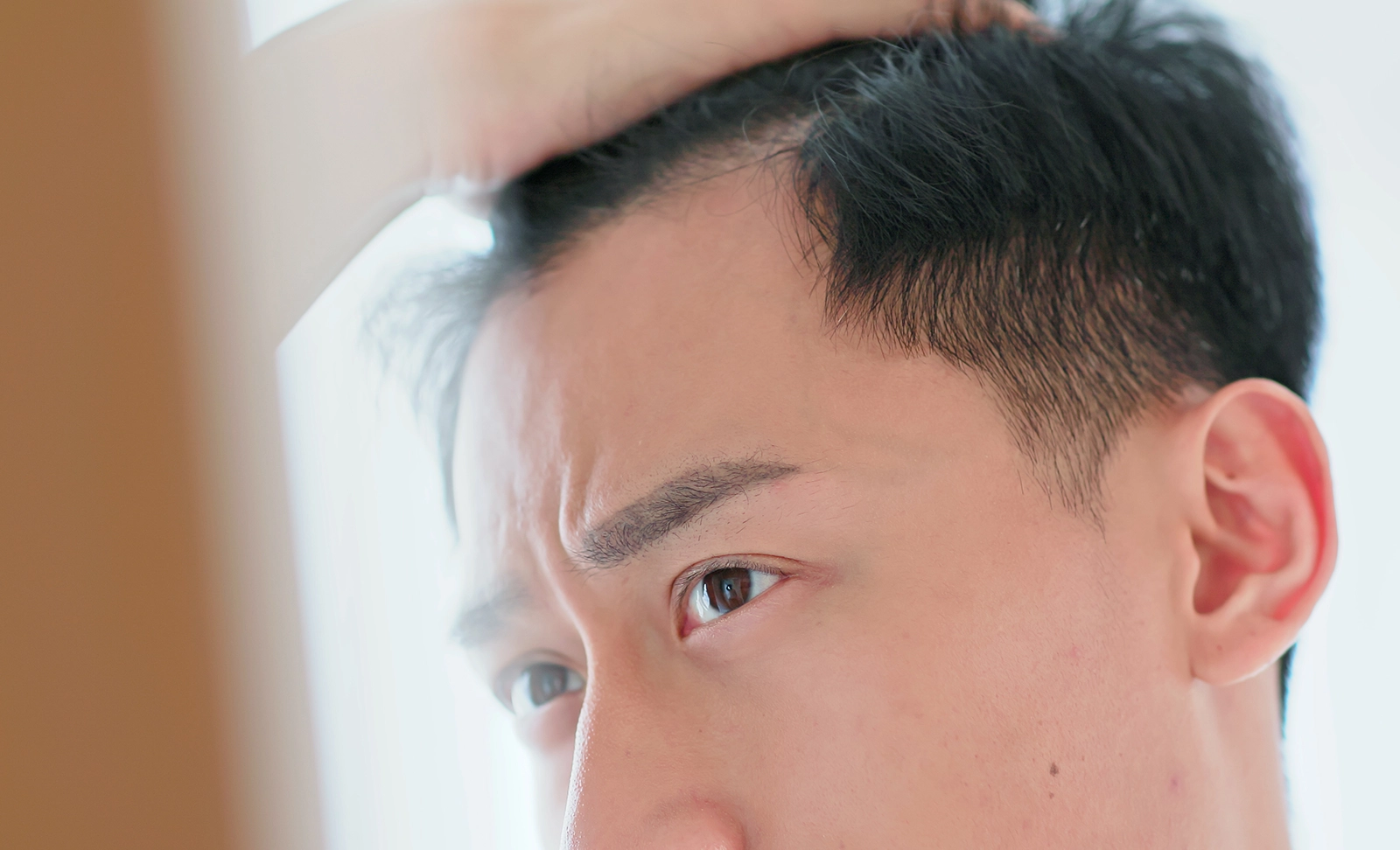Do you have an asymmetrical hairline? It can be quite disconcerting, especially if you have never noticed it before, and you may even worry that it’s a sign that your hair is falling out. The question is, does an uneven hairline always indicate hair loss, or could it be something else? This article will help you understand the potential causes of your uneven hairline, including ways to fix it.
What is an Uneven Hairline?
Simply put, an uneven hairline is a hairline that is not symmetrical. For example, you might notice that one side of your hairline is further down than the other side. It won’t look completely straight across the forehead.
Are Uneven Hairlines Common?
Yes – both men and women can experience an uneven hairline, and they are very common. Most people don’t have an exactly symmetrical face; it’s normal for features to differ slightly on one side. Sometimes it’s obvious, and other times it is extremely subtle. It’s exactly the same with an uneven hairline.
Does an Uneven Hairline Mean Hair Loss?
Not necessarily. There may be a hair loss connection there, but that doesn’t mean your uneven hairline is 100% an indicator of hair loss.
What an Uneven Hairline Could Indicate
To help you understand what your uneven hairline could mean, here are the usual causes.
Genetics
Some people naturally have an uneven hairline, and this is due to genetics. If your mother or father has an uneven hairline, there is a higher chance that you will also have one. In this case, there is nothing to worry about; you only need to worry about hair loss if the hairline changes over time (for example, there is more recession at the temples).
Hair Styling Methods
Some hair styling methods may change your hairline over time. For example, if you style your hair in a parting, you may find that one side of the hairline becomes higher than the other. This could also be caused by traction alopecia, which we’ll go into further down below.
Hair Loss
Yes – in some circumstances, an uneven hairline points towards hair loss. It’s normal for hair loss to start slow and affect just one area of the scalp at first. So, you might find you begin losing hair on one side of your hairline but not the other.
What Causes Hair Loss?
If you think your uneven hairline may be due to hair loss, it helps to understand what is causing it.
Stress
It’s true: stress can have a significant impact on your strands. Too much mental or physical stress can lead to telogen effluvium, a type of temporary hair loss that causes hair to shed quickly.
Traction Alopecia
Traction alopecia is a type of hair loss caused by physical damage to the hair follicles. It often occurs due to too-tight hairstyles such as dreadlocks, braids, and tight buns/ponytails. Unfortunately, hair loss caused by traction alopecia can be permanent.
Health Conditions
Certain health conditions can lead to hair loss. That includes alopecia areata, thyroid disorders, lupus, anaemia, and hyperandrogenism.
Hormonal Changes
Hormonal changes have a significant impact on your hair. That’s why it’s so common for postpartum and menopausal women to experience hair loss.
Certain Medications
The medications you take may lead to hair loss. For example, chemotherapy drugs, anti-coagulants, antidepressants, and some antibiotics may cause the hair to fall out. It’s crucial to speak with your doctor before stopping or starting a medication, and always seek immediate medical care if you exhibit serious side effects.
Nutritional Deficiencies
Your diet plays a big role in hair growth. If you do not get enough vitamins A, B, C, or E, or there isn’t enough iron or zinc in your diet, then you may experience hair thinning and loss.
Androgenetic Alopecia
The most common cause of hair loss is androgenetic alopecia, also known as male pattern hair loss or female pattern hair loss. Androgenetic alopecia is all down to genetics, so you are more likely to experience it if your family members also have hair loss.
How to Tell if Your Uneven Hairline is Caused by Hair Loss
If you are still unsure about whether or not you are losing your hair, here are some ways to tell:
Compare with Old Photos
If you have only just noticed your receding hairline, you may wonder if it has been there all along. The easiest way to determine this is by comparing your hairline now with older photographs. If it looks the same as it did, say, five years prior, then you don’t have to worry – it’s likely a naturally uneven hairline!
Look at Your Parent’s Hairline
Do your parents have an uneven hairline? If so, the chances are your uneven hairline is simply genetic and you don’t need to worry.
Check Your Hairbrush and Shower Drains
The easiest way to see whether you are experiencing hair loss is by checking your hairbrush and shower drains. Are your locks clogging the drains? Do you find more hair comes out when you are styling it in the morning? If so, that’s a clear indicator that you are losing some hair, so it’s worth addressing that.
How to Fix Uneven Hairline
So, you have noticed you definitely have an uneven hairline. What next?
Determine the Cause
Before you jump towards a hair loss treatment, consider the cause. After all, your uneven hairline might be due to genetics or natural ageing, so there isn’t much you can do about it. You could use a hair track app to see if your hairline gets more uneven over time. It also helps to speak to a doctor or hair specialist, especially if you notice sudden hair loss.
Play with New Hairstyles
There are plenty of ways to hide an uneven hairline! If it is bothering you, you can play with new hairstyles to hide it. Some great hairstyles to hide a hairline include a longer fringe and a buzz cut.
Improve Your Lifestyle
Improving your lifestyle can help reduce hair loss around the hairline. Incorporating good habits into your life helps here, such as exercising more regularly, maintaining a stable work-life balance, and eating a healthy diet that’s rich in all the essential nutrients.
Use a Hair Loss Medication
There are several hair loss medications available that can restore your hairline, including minoxidil, finasteride, and dutasteride. Finasteride and dutasteride are only prescribed to men, as they work by blocking the male hormone DHT. Minoxidil is a topical hair loss medication (although it also comes in oral form) available over the counter to both men and women. Keep in mind you must continually take any of these medications for the results to stick.
Try an Alternative Hair Restoration Treatment
There are plenty of effective alternative hair restoration options out there, including PRP injections, microneedling, and low-level laser therapy. All have undergone studies showing that they can regrow the hair. For example, one clinical trial [1] showed that low-level laser therapy helped regrow hair in mice with chemotherapy-induced alopecia.
Get a Hair Transplant
If you are looking for a permanent solution to hair loss or an uneven hairline, the best option is a hair transplant. Hair transplants take follicles from a healthy area of the scalp and transplant them to the area that is thinning or balding – in this case, the hairline. Once they have taken root, new hairs grow through, and these will last forever. It’s an excellent option as you don’t have to worry about taking daily medication or keeping up with trips to the clinic for laser therapy or microneedling. Plus, the results speak for themselves – check out this patients gallery to see how effective hair transplants are.
Are You a Good Candidate for a Hair Transplant?
A hair transplant may seem like the best solution for your uneven hairline that’s caused by hair loss, but not everyone is a good candidate. Here’s what to consider.
Cost: Hair transplants are not exactly cheap, with some spending upwards of £10,000 on them. The exact price depends on your needs. If you don’t have the funds, you might find it best to start with another hair loss treatment, at least to begin with.
Medical History: Some people aren’t good candidates for hair transplants due to medical conditions. For example, those with certain autoimmune conditions or skin disorders may not be able to get a hair transplant.
Extent of Hair Loss: The extent of your hair loss determines whether a hair transplant is right for you. For example, if you have hair loss all over your head, you won’t have a good donor site; therefore, the hair transplant process will not work.
It helps to speak to a hair specialist about your uneven hairline and the options that work best for you.
Final Thoughts
An uneven hairline does not necessarily point towards hair loss, although it can be an indicator. It’s best to look at other signs of hair loss to determine whether you are losing your hair. From there, you can look into hair restoration options to restore your hair to how it once was.
Sources:




